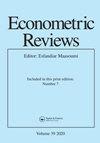Large dimensional portfolio allocation based on a mixed frequency dynamic factor model
IF 1
4区 经济学
Q3 ECONOMICS
引用次数: 0
Abstract
Abstract In this paper, we propose a mixed-frequency dynamic factor model (MFDFM) taking into account the high-frequency variation and low-frequency variation at the same time. The factor loadings in our model are affected by the past quadratic variation of factor returns, while the process of the factor quadratic variation is under a mixed-frequency framework (DCC-RV). By combing the variations from the high-frequency and low-frequency domain, our approach exhibits a better estimation and forecast of the assets covariance matrix. Our empirical study compares our MFDFM model with the sample realized covariance matrix and the traditional factor model with intraday returns or daily returns. The results of the empirical study indicate that our proposed model indeed outperforms other models in the sense that the Markowitz’s portfolios based on the MFDFM have a better performance.基于混合频率动态因子模型的大维投资组合配置
摘要在本文中,我们提出了一个同时考虑高频变化和低频变化的混合频率动态因素模型(MFDFM)。我们模型中的因子负荷受到过去因子收益的二次变化的影响,而因子二次变化过程是在混合频率框架下(DCC-RV)。通过结合高频和低频域的变化,我们的方法对资产协方差矩阵进行了更好的估计和预测。我们的实证研究将我们的MFDFM模型与样本实现的协方差矩阵进行了比较,并将传统的因子模型与日内收益或日内收益进行了比较。实证研究的结果表明,我们提出的模型确实优于其他模型,因为基于MFDFM的Markowitz投资组合具有更好的性能。
本文章由计算机程序翻译,如有差异,请以英文原文为准。
求助全文
约1分钟内获得全文
求助全文
来源期刊

Econometric Reviews
管理科学-数学跨学科应用
CiteScore
1.70
自引率
0.00%
发文量
27
审稿时长
>12 weeks
期刊介绍:
Econometric Reviews is widely regarded as one of the top 5 core journals in econometrics. It probes the limits of econometric knowledge, featuring regular, state-of-the-art single blind refereed articles and book reviews. ER has been consistently the leader and innovator in its acclaimed retrospective and critical surveys and interchanges on current or developing topics. Special issues of the journal are developed by a world-renowned editorial board. These bring together leading experts from econometrics and beyond. Reviews of books and software are also within the scope of the journal. Its content is expressly intended to reach beyond econometrics and advanced empirical economics, to statistics and other social sciences.
 求助内容:
求助内容: 应助结果提醒方式:
应助结果提醒方式:


